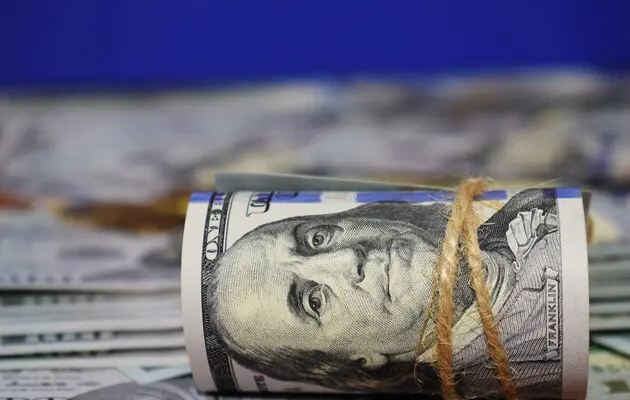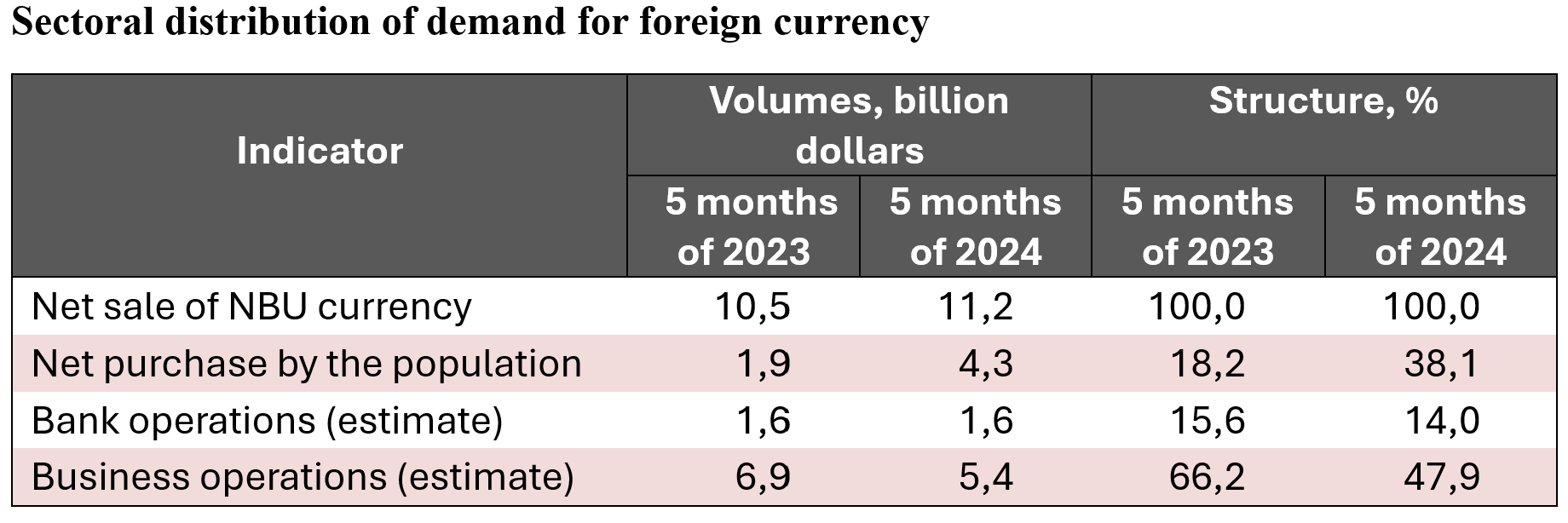Forex Market Fever. Causes, Consequences, Forecasts
According to the results of May, the results of large-scale currency liberalization are doubtful, because foreign exchange reserves decreased by 3.4 billion dollars. Currently, this is a record reduction of currency reserves within one month since the beginning of the war. Is the decision of the National Bank of Ukraine (NBU) to remove all restrictions on the import of services and limits on payments under new loans for the benefit of non-residents worth such costs?
In January-May, the National Bank of Ukraine (NBU) sold 11.2 billion dollars on the interbank foreign exchange market (minus purchases) through currency interventions. Weekly net sales of the currency have been noticeably high in recent weeks.
The increase in demand for foreign currency is mainly related to pressure from the population and small businesses. In January-May 2024, they bought cash currency worth 9.7 billion dollars, which is 2.6 billion dollars more than in the same period last year.
In the five months of 2024, the share of the population and small businesses in the demand for foreign currency amounted to 38%, which is more than twice as high as last year. At that time, the share of the population was only 18% (see the table).
Ukrainian banks continue to increase their foreign assets. In January-May 2024, banks increased their net foreign assets by 1.6 billion dollars. That is, banks not only accumulate internal hryvnia liquidity, but also diligently transfer it to external assets (mainly in the form of foreign currency and deposits).
The increase in the activity of the population and banks in transactions involving the purchase of foreign currency indicates an imbalance in currency expectations.
It should be noted that in 2024, as in 2022–2023, most of the new hryvnia liquidity entering the economy will be converted into foreign currency. At the same time, the currency conversion ratio is constantly increasing: in 2022 it was 68%, in 2023 - 75%, in May 2024 - 86%.
A significant increase in currency pressure was recorded precisely in those periods the National Bank of Ukraine (NBU) announced its steps regarding currency liberalization and the abolition of currency restrictions. Thus, each time, namely after the announcement of the Strategy for Softening Currency Restrictions (August 2023), after the transition to flexible exchange rate formation (October 2023) and after the large-scale abolition of currency restrictions (May 2024) by the National Bank of Ukraine (NBU) excessive spending of currency reserves to support the exchange rate was observed.
In the conditions of war, it is objectively impossible to find a market equilibrium point for an exchange rate regulated within the framework of a free market. This is due to the fact that the currency supply-demand ratio is under permanent pressure from shock factors of a non-market nature (import of electrical equipment, import of weapons and components for their production, import of medical equipment, lack of export revenue due to the destruction of production facilities and infrastructure, etc.). This exerted significant psychological pressure on the exchange rate of the national currency.
In addition, a significant part of foreign currency inflows to Ukraine is of a non-market nature – preferential foreign loans, grants, humanitarian and charitable aid. The influence of such factors causes constant fluctuations in the supply and demand of foreign currency and significant currency imbalances, which requires stabilizing interventions of the National Bank of Ukraine (NBU).
Since Ukraine's balance of payments remains structurally deficient (over 30 billion dollars per year), and the country's economy operates under conditions of numerous non-market shocks, it is absolutely natural that after the abolition of currency restrictions and the introduction of flexible exchange rates, the demand for foreign currency increased significantly and the negative expectations of market subjects increased. It can even be said that the policy of the National Bank of Ukraine (NBU) has programmed an increase in currency instability.
If before the introduction of the regime of managed flexibility, the costs of foreign exchange reserves amounted to less than 2 billion dollars per month, after the transition they increased by a third - an average of 2.6 billion dollars per month. In unison with the spending of foreign exchange reserves, the volume of cash currency outside banks grew, which reached 126 billion dollars by the end of April 2024, and since the beginning of the war it has increased by 30 billion dollars (50% of all currency interventions by the National Bank of Ukraine (NBU)). That is, indirectly, the easing of the NBU's currency restrictions contributed to the flow of official currency reserves into cash foreign currency of the private sector.
Despite significant currency challenges, since May the National Bank of Ukraine (NBU) has introduced the largest package of softening currency restrictions since the beginning of the full-scale war. Unfortunately, this decision of the regulator exacerbated the fundamental currency risks of the Ukrainian economy and led to new unjustified losses of currency reserves. Back in mid-May, the head of the National Bank of Ukraine (NBU) confidently stated that the "cost" of the liberalization of currency regulation will not affect the size of international reserves, which will remain at the level of 43-44 billion dollars in 2024-2025. However, let's not forget that maintaining currency reserves at a safe level is now also provided by the government, which attracts 30–40 billion dollars of foreign aid per year.
It is known that the rate of recovery of Ukrainian Gross Domestic Product (GDP) after a 29% drop in 2022 is quite weak. In addition, the rate of growth of Ukrainian exports is slow even after the launch of the new Black Sea Corridor. At the same time, banks intensified their investments in foreign currency assets instead of expanding business lending. Since the beginning of the war, the banking system has accumulated gigantic amounts of free bank liquidity (about 20 billion dollars), which do not bring productive benefits to the real sector and the economy as a whole.
Despite the statement of the National Bank of Ukraine (NBU) about the success of the policy of attracting hryvnia assets, the current interest rate policy has created conditions under which Ukrainian producers are not only forced to compete with imports but are also deprived of access to cheap credit resources (unlike foreign producers). This directly affected the volume of the foreign trade deficit.
Starting from March 2024, against the backdrop of new attacks by the enemy on infrastructure, the exchange rate was under additional threat. As at the beginning of the war, there are not enough weapons, there is a shortage of human resources at the front, and the import of fuel and energy equipment is growing noticeably. In such extreme conditions, the policy of the National Bank of Ukraine (NBU) further reduces the competitiveness of Ukrainian producers and increases the currency risks of the economy.
At the same time, the National Bank of Ukraine (NBU) has been actively spending foreign exchange reserves, which are fully formed from international aid, in recent months to support the exchange rate. The reason for this situation is not only the structural gaps in the balance of payments, but also the removal of currency restrictions and the transition to a managed floating exchange rate.
The high discount rate of the National Bank of Ukraine (NBU) and the policy of attracting hryvnia assets in no way contributed to a decrease in demand for foreign currency or an increase in its supply. The transition of hryvnia savings into cash currency is only accelerating, and the volume of inflow of foreign investments and private loans to Ukraine is small.
Currently, all time hryvnia deposits of businesses and the population amount to only 12 billion dollars (in equivalent), while the National Bank of Ukraine (NBU) has already spent 60 billion dollars for their mobilization and retention in banks.
Measures that would help to overcome the imbalance of the currency market instead:
- postponement of currency softening of the National Bank of Ukraine (NBU) restrictions until the end of the war.
- fixing the exchange rate to stabilize currency expectations (for example, at the level of +10% in accordance with the inflation expectations of the National Bank of Ukraine (NBU)).
- reduction of interest rate policy parameters to a level adequate to inflation.
In the future, it would not be a problem to reorient the work of the National Bank of Ukraine (NBU) towards such goals as increasing the level of financial intermediation and developing monetary instruments to support economic growth.
Read this article in Ukrainian and russian.
Please select it with the mouse and press Ctrl+Enter or Submit a bug













 Login with Google
Login with Google